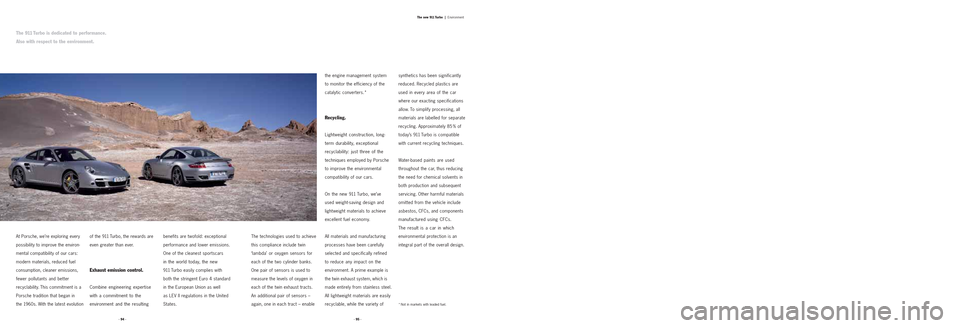At Porsche, we’re exploring every
possibility to improve the environ-
mental compatibility of our cars:
modern materials, reduced fuel
consumption, cleaner emissions,
fewer pollutants and better
recyclability. This commitment is a
Porsche tradition that began in
the 1960s. With the latest evolutionof the 911 Turbo, the rewards are
even greater than ever.
Exhaust emission control.
Combine engineering expertise
with a commitment to the
environment and the resulting
benefits are twofold: exceptional
performance and lower emissions.
One of the cleanest sportscars
in the world today, the new
911 Turbo easily complies with
both the stringent Euro 4 standard
in the European Union as well
as LEV II regulations in the United
States.The technologies used to achieve
this compliance include twin
‘lambda’ or oxygen sensors for
each of the two cylinder banks.
One pair of sensors is used to
measure the levels of oxygen in
each of the twin exhaust tracts.
An additional pair of sensors –
again, one in each tract – enablethe engine management system
to monitor the efficiency of the
catalytic converters.*
Recycling.
Lightweight construction, long-
term durability, exceptional
recyclability: just three of the
techniques employed by Porsche
to improve the environmental
compatibility of our cars.
On the new 911 Turbo, we’ve
used weight-saving design and
lightweight materials to achieve
excellent fuel economy.
All materials and manufacturing
processes have been carefully
selected and specifically refined
to reduce any impact on the
environment. A prime example is
the twin exhaust system, which is
made entirely from stainless steel.
All lightweight materials are easily
recyclable, while the variety ofsynthetics has been significantly
reduced. Recycled plastics are
used in every area of the car
where our exacting specifications
allow. To simplify processing, all
materials are labelled for separate
recycling. Approximately 85 % of
today’s 911 Turbo is compatible
with current recycling techniques.
Water-based paints are used
throughout the car, thus reducing
the need for chemical solvents in
both production and subsequent
servicing. Other harmful materials
omitted from the vehicle include
asbestos, CFCs, and components
manufactured using CFCs.
The result is a car in which
environmental protection is an
integral part of the overall design.
· 94 ·· 95 ·The new 911 Turbo |
Environment
* Not in markets with leaded fuel.
The 911 Turbo is dedicated to performance.
Also with respect to the environment.
